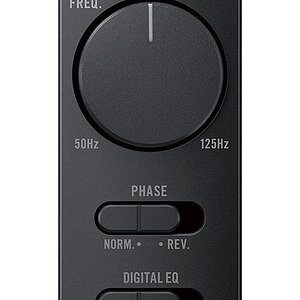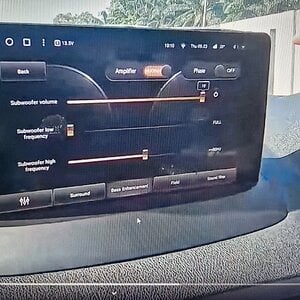You are using an out of date browser. It may not display this or other websites correctly.
You should upgrade or use an alternative browser.
You should upgrade or use an alternative browser.
Marve_Lous
That Guy
Buck 5,000+ posts
little alien on campus
I would just go with what the manufacturer specs are, personally.
Why do you need to know the exact Fs? Box building or just want to have a sub with a lower or high Fs or?
Why do you need to know the exact Fs? Box building or just want to have a sub with a lower or high Fs or?
THATpurpleKUSH 5,000+ posts
Fuckyou
I don’t know of any subs that change Fs after break in. One seller just has the wrong numbers.
This is a factually incorrect and complete ignorant statement.
When a driver's suspension loosens after break in, an inherent effect of the suspension softening is in fact a drop in fs.
The amount that fs changes depends on the driver and materials used to build it.
This change can be further backed up with equipment that can measure tsp data like the Klippel or Dayton DATS system by completing a before and after measurement of ts parameters.
That being said, manufacturer listed tsp data is rarely accurate and often manipulated by the manufacturer's marketing department. Often listed specs are an average from the production run.
The only true way to know is by physically measuring the data with a Klippel, DATS or other reputable accurate method.
edit: further example using a Blaupunkt GBW801 pre break on the left and post break in on the right.
Break in consisted of playing 25hz free air on roughly 25% power handling for 10 mins.
Note the roughly 14% drop in fs after break in, I still wouldn't call the #'s 100% accurate due to the vas measuring method needed for the DATSv2 but there's enough data there that I would call close enough to make analysis.
compare that to what the manufacturer provides:
Last edited:
Marve_Lous
That Guy
Good info. Learn something new everyday. Now I’m curious. Isn’t Fs a spec used in programs like winisd to design an enclosure? If so, if that figure will change after break in, how big of an effect does that have on the box you designed based on the pre break in figure?When a driver's suspension loosens after break in, an inherent effect of the suspension softening is in fact a drop in fs.
The amount that fs changes depends on the driver and materials used to build it.
This change can be further backed up with equipment that can measure tsp data like the Klippel or Dayton DATS system by completing a before and after measurement of ts parameters.
That being said, manufacturer listed tsp data is rarely accurate and often manipulated by the manufacturer's marketing department. Often listed specs are an average from the production run.
The only true way to know is by physically measuring the data with a Klippel, DATS or other reputable accurate method.
edit: further example using a Blaupunkt GBW801 pre break on the left and post break in on the right.
Break in consisted of playing 25hz free air on roughly 25% power handling for 10 mins.
Note the roughly 14% drop in fs after break in, I still wouldn't call the #'s 100% accurate due to the vas measuring method needed for the DATSv2 but there's enough data there that I would call close enough to make analysis.
View attachment 26141
compare that to what the manufacturer provides:
View attachment 26144
Buck 5,000+ posts
little alien on campus
Good info. Learn something new everyday. Now I’m curious. Isn’t Fs a spec used in programs like winisd to design an enclosure? If so, if that figure will change after break in, how big of an effect does that have on the box you designed based on the pre break in figure?
Fs can change port velocity quite a bit at different frequencies. Fs can be important if it's really off.
Buck 5,000+ posts
little alien on campus
Several manufacturers post T/s after a short break in. But a lot of recommendations for woofers are from playing them a lot. But I've ran across quite a few t/s parameters where they seem way off. Like memphis mojo6 vas was like 450 liters off.....
Marve_Lous
That Guy
Ahh, so the manufacturer’s Fs is or should be the subs post break in figure.Several manufacturers post T/s after a short break in. But a lot of recommendations for woofers are from playing them a lot. But I've ran across quite a few t/s parameters where they seem way off. Like memphis mojo6 vas was like 450 liters off.....
THATpurpleKUSH 5,000+ posts
Fuckyou
Ahh, so the manufacturer’s Fs is or should be the subs post break in figure.
Ideally yes but that varies highly depending on the manufacturer.
A company like Sundown that monitors their quality control relatively closely, I would trust the tsp info they provide, esp since they pull data with a Klippel.
A less reputable company like Skar or a large company with a big production batch is more likely to provide an averaged crapshoot of numbers that in actuality will vary widely.
Buck 5,000+ posts
little alien on campus
Ahh, so the manufacturer’s Fs is or should be the subs post break in figure.
Hopefully lol. That's where experience comes in with box designing like I do. I've done so many boxes that I know what subs are going to do in certain situations, regardless of what the t/s say. You can spot bad t/s in modeling software like winisd, or bbp6 or whatever. Designing boxes is largely an art form, when it comes to tuning and sometimes airspace. I mean I use very accurate math to calculate displacements and net airspace, but determine tuning and what size box a sub wants from t/s alone can be dangerous, because t/s is misleading sometimes or even often. I don't care what the situation is- whether it's box designing or rocket science or quantum physics- it doesn't matter what the math says, it matters how the situation actually works in reality. People get obsessed with numbers too much, and don't have enough experience to make an executive call. The t/s is an important but sometimes useless part of box designing. The real world doesn't lie fyi
That's because Memphis Audio is trash. I hate that company. I'd buy Skar before themSeveral manufacturers post T/s after a short break in. But a lot of recommendations for woofers are from playing them a lot. But I've ran across quite a few t/s parameters where they seem way off. Like memphis mojo6 vas was like 450 liters off.....
Buck 5,000+ posts
little alien on campus
That's because Memphis Audio is trash. I hate that company. I'd buy Skar before them
We definitely agree on that one LOL
hispls 5,000+ posts
CarAudio.com Veteran
This is all true and the specs you have posted seem to change roughly as much as I'd expect to be consistent with woofers I have measured. Also I would say that after 10 minutes of hard play (or whatever test tone ritual you prefer) you shouldn't expect much more variance in the future. The vast majority of TSP change from suspension softening happens very quickly.This is a factually incorrect and complete ignorant statement.
When a driver's suspension loosens after break in, an inherent effect of the suspension softening is in fact a drop in fs.
The amount that fs changes depends on the driver and materials used to build it.
This change can be further backed up with equipment that can measure tsp data like the Klippel or Dayton DATS system by completing a before and after measurement of ts parameters.
That being said, manufacturer listed tsp data is rarely accurate and often manipulated by the manufacturer's marketing department. Often listed specs are an average from the production run.
The only true way to know is by physically measuring the data with a Klippel, DATS or other reputable accurate method.
edit: further example using a Blaupunkt GBW801 pre break on the left and post break in on the right.
Break in consisted of playing 25hz free air on roughly 25% power handling for 10 mins.
Note the roughly 14% drop in fs after break in, I still wouldn't call the #'s 100% accurate due to the vas measuring method needed for the DATSv2 but there's enough data there that I would call close enough to make analysis.
View attachment 26141
compare that to what the manufacturer provides:
View attachment 26144
As to what manufacturers chose to publish, who knows who is doing what, but as an interesting aside I pulled TS paremeters from an old Clarion 32" woofer that belongs to a friend and got precisely the specs that Clarion published back in the 90s. I've pulled some specs from midranges as well that lined up within a very tight tolerance of published.
Activity
No one is currently typing a reply...
Similar threads
i would not worry about the tweeters. They will never see anything above 20 watts before your ears bleed. your options with 4 channels would be...
- Started by QKA
- Wiring, Electrical & Installation
- 4
- 343
- Poll
That strikes me as overboard. We'll probably survive if a thread or two every week comes back from the dead.
- Started by HardofWhoring
- Forum News, Bug & Usage Issues 2
- 18
- 3K
Hell... Run It!! If it sounds good to you. Then that is what matters the most.. Your OWN EARS.
- Started by Matts175
- General Car Audio
- 6
- 2K
Crap, I really need D4 for the pair or I'll need another amp...
- Started by gunz4me2
- Subwoofers
- 8
- 2K
This option is better because you need 3 pairs of RCA cables. Tweeters, midrange, and bass. You then use a Y at the amps on the Bass run, then use...
- Started by Here2LearnThings
- Wiring, Electrical & Installation
- 8
- 3K


